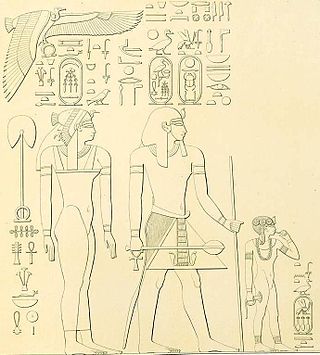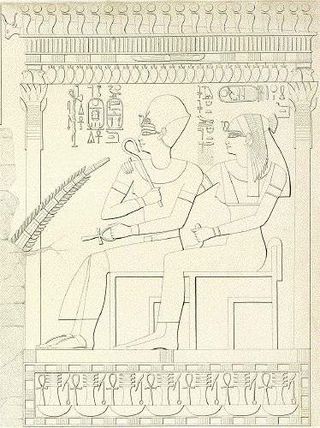
Menkheperre, son of Pinedjem I by wife Duathathor-Henuttawy, was the High Priest of Amun at Thebes in ancient Egypt from 1045 BC to 992 BC and de facto ruler of the south of the country.

Masaharta or Masaherta was the High Priest of Amun at Thebes between 1054 and 1045 BC.

Henutmire was an ancient Egyptian princess and queen. She was one of the eight Great Royal Wives of Pharaoh Ramesses II of the 19th Dynasty of Egypt.

Nebettawy(nb.t-t3.wỉ; “Lady of the Two Lands”) was an ancient Egyptian princess and queen, the fifth daughter and one of the eight Great Royal Wives of Pharaoh Ramesses II.

Satiah was an ancient Egyptian queen, the first Great Royal Wife of Pharaoh Thutmose III.

Nebtu was an ancient Egyptian, the wife of Thutmose III.

Iset was a queen of the Eighteenth Dynasty of Egypt, and she was named after goddess Isis. She was a secondary wife or concubine of Thutmose II.
Beketamun or Beket was a princess of the Eighteenth Dynasty of Egypt, a daughter of Pharaoh Thutmose III. Her name means “Handmaid of Amun”.
Menkheperre was a prince of the Eighteenth Dynasty of Egypt, one of two known sons of Pharaoh Thutmose III and his Great Royal Wife Merytre-Hatshepsut. His name is the throne name of his father and means “Eternal are the manifestations of Re”.
Nebetiunet was a princess of the Eighteenth Dynasty of Egypt, a daughter of Pharaoh Thutmose III and his Great Royal Wife Merytre-Hatshepsut.

Meritamen was the name of two princesses during the Eighteenth Dynasty of Egypt, referred to as Meritamen C and Meritamen D by modern historians. Both were the daughters of Pharaoh Thutmose III and his Great Royal Wife Merytre-Hatshepsut. Their name is alternatively spelled Meritamun.

Nefertari was a queen of the Eighteenth Dynasty of Egypt, the first Great Royal Wife of Pharaoh Thutmose IV.

Tiaa or Tia'a was an ancient Egyptian queen consort during the Eighteenth Dynasty of Egypt. She was a "faceless concubine" during the time of Amenhotep II who withheld from her the title Great Royal Wife, but when her son Thutmose IV became pharaoh, he performed a revision of her status and gave her that title.

Neferubity was an ancient Egyptian princess of the 18th Dynasty. She was the daughter of Pharaoh Thutmose I and Ahmose, the sister of Hatshepsut and the half-sister of Thutmose II, Wadjmose and Amenmose.
Hui or Huy was an ancient Egyptian priestess during the Eighteenth Dynasty. She was the mother of Merytre-Hatshepsut, the Great Royal Wife of Pharaoh Thutmose III.

Duathathor-Henuttawy, Henuttawy or Henttawy("Adorer of Hathor; Mistress of the Two Lands") was an ancient Egyptian princess and later queen.
Meritamen, also spelled Meritamun, Merytamen, Meryetamen is an ancient Egyptian female name. Its male counterpart is Meryamen or Meryamun.

Queen Merytre-Hatshepsut was the Great Royal Wife of Pharaoh Thutmose III after the death of Queen Satiah. She was the mother of Pharaoh Amenhotep II.

Baketmut was an ancient Egyptian princess of the Nineteenth Dynasty. She was the second daughter of Pharaoh Ramesses II.
This page is based on this
Wikipedia article Text is available under the
CC BY-SA 4.0 license; additional terms may apply.
Images, videos and audio are available under their respective licenses.












